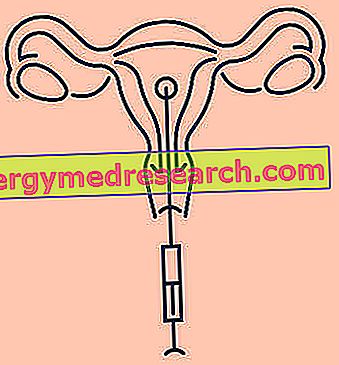Generality
IUI (from the English "Intra-Uterine Insemination", ie intrauterine insemination) is the simplest of the medically assisted procreation techniques used in the treatment of infertility .

IUI can be performed on a spontaneous cycle or with moderate pharmacological stimulation for multiple follicular growth. In the latter case, ultrasound checks and hormonal dosages are performed to follow the progress of ovulation during treatment.
In general, intrauterine insemination is indicated in cases of unexplained sterility, moderate alteration of some parameters of seminal fluid, cervical factors or impediments to sexual intercourse.
Before embarking on this path, the tubal patency must be verified, the absence of infections in the male and female genital tract and an acceptable quality of the spermatozoa (number, movement and morphology).
The fertilization takes place, therefore, directly inside the female genital apparatus. The technique is ambulatory, minimally invasive and not painful.
IUI is a first-level technique of medically assisted procreation (PMA), therefore it is one of the least invasive methods recommended to a couple who wants to have a child.
Medical-assisted procreation
Medically assisted procreation (PMA) helps couples who wish to have a child, but cannot spontaneously undertake a pregnancy. This option is indicated by the doctors as part of a treatment course, in cases where the infertility of at least one of the two partners is ascertained and there are no other effective therapeutic methods to resolve this condition.
Assisted fertilization uses more or less complex techniques, which involve the manipulation of female gametes (oocytes), male (spermatozoa) or embryos.
- The first level methods include: hormonal stimulation, ultrasound monitoring of women's ovulation and intrauterine insemination (IUI); the latter is characterized by the fact that fertilization takes place directly within the female genital apparatus.
- Second and third level treatments, on the other hand, require fertilization to take place first in vitro and include: IVF (in vitro fertilization with embryo transfer), ICSI and GIFT (intratubarial transfer of gametes). These procedures are more invasive and are indicated when the infertility to be addressed is serious.
Indications
Intrauterine insemination (IUI) is the technique of medical-assisted procreation that most respects the normal stages of reproduction processes .
This method is indicated in the presence of sterility of unknown origin, to which, that is, it is not possible to attribute a cause. In particular, IUI is recommended in the presence of coital factors, when spermatozoa have difficulty reaching the uterus (impotence, modest alteration of sperm quality, etc.) and / or in cases where the male partner has been subjected to a vasectomy . In the latter case, the seminal fluid is obtained through a puncture of the vas deferens and, once a sufficient sample is obtained, it is used for artificial insemination.
In the presence of a concentration of sperm below the average, with little motility or with anomalies of size and shape, the IUI can manage to compensate for these problems, since the preparation of the sperm before the procedure helps to separate the vital spermatozoa and with motility preserved, compared to those of lower quality.
Intrauterine insemination can be used successfully even in rather rare situations, as in the case of men suffering from retrograde ejaculations (inside the bladder), caused by prostatic surgery, or in the presence of some pathologies of the genital tract, such as in the case of hypospadias, in which it is difficult or impossible to have a complete sexual relationship.
IUI is also indicated in the presence of mild endometriosis, ovulatory dysfunctions and immunological factors (production of anti-sperm antibodies by the male organism or by the partner).
This approach can also be useful in cases of repeated failures of induction of pregnancy with ovarian stimulation with drugs and targeted sexual intercourse (that is, that is, during the days of probable ovulation).
IUI is also suitable in the presence of anatomical and / or functional alterations of the cervix (cervical factor) or of a fallopian tube ( unilateral tubal factor ).
Essential conditions for the success of the IUI are:
- Seminal fluid sample with mild or moderate oligo-astenospermia;
- Conserved tubal function (at least unilateral).
The chances of becoming pregnant vary from 10% to 15% per attempt, depending on the underlying pathology and the age of the patient.
IUI homologous and heterologous
- Homologous intrauterine insemination consists of the artificial introduction into the uterine cavity of the partner's seminal fluid. This procedure can be useful in cases of scarcely reduced male fertility (total sperm concentration or number of high mobility spermatozoa slightly below the norm) and in the absence of tubal occlusion in women.
- Heterologous intrauterine insemination involves the use, instead, of sperm from a donor and is suitable when the characteristics of the seminal fluid are such as to completely compromise reproductive function.
Preliminary medical investigations
If a couple fails to procreate in spite of targeted sexual intercourse, over a period of 12-24 months, it is necessary to examine the causes of the conception difficulties from a medical point of view.
Before executing the IUI, the doctor meets the two patients and draws up a medical history based on their medical history, then recommends a series of specific tests to rule out the presence of hormonal dysfunctions, pathologies affecting the uterus and tubes, abnormalities of the seminal fluid and so on
For the couple
- Hormonal dosages;
- Genetic investigations;
- Immunological tests for the presence of anti-sperm antibodies.
For man
- Spermiogramma (examination of the seminal fluid to assess its fertilizing capacity and other fundamental functions, such as the number, morphology and percentage of motile spermatozoa);
- Spermioculture (sperm analysis to assess the presence of infectious agents in the genital organs).
For the woman
- Hysterosalpingography (to check the state of the tubes and their patency);
- Ultrasound of the uterus and ovaries (it allows to control ovulation, the quantity of oocytes, the presence of possible cysts, fibroids or other formations);
- Hysteroscopy (endoscopic examination of the uterine cavity);
- Pap test (cytological examination that investigates the presence of an HPV lesion and the alterations of the cells at the level of the cervix);
- Search for infectious agents (eg vaginal swab for the detection of common pathogens such as Chlamydia and Candida).
If the conditions encountered cannot be managed with other appropriate pharmacological and / or surgical interventions, then if procreation is impossible or in any case the probability of starting a pregnancy is remote, recourse to medically assisted procreation may be indicated. According to the cause of infertility, therefore, the specialist of the PMA center can advise the IUI or another more suitable procedure for the couple's profile.
How is it done?
IUI simply imitates natural reproduction in the uterus: the male seed is deposited directly in the uterus at the time of ovulation, therefore the meeting of the spermatozoa with the oocyte and fertilization normally take place in the female genital apparatus. This is especially useful when spermatozoa have difficulty overcoming vagina and cervix due to an obstacle or a lack of quantity or quality of sperm.
1. Control and stimulation of the ovaries
IUI can be implemented on a spontaneous cycle or with an induction of ovulation through the administration of drugs (generally recombinant gonadotropins) starting from the second-third day of the menstrual cycle. The goal is to stimulate the ovaries to produce more than one follicle and to mature 2-3 egg cells to increase the chance that at least one of these is fertilized.
Based on the size of the follicles, the thickness of the uterine mucosa and with the use of the ovulation test, it is possible to predict the time of ovulation of the current cycle. Furthermore, ultrasound monitoring of ovulation, carried out during the course of therapy, allows the dose of drugs to be modified to optimize the ovarian response and personalize the treatment.
Usually, as soon as two or three follicles have reached certain dimensions (about 18 mm), ovulation is induced by pharmacological way, with the injection of human chorionic gonadotropin (hCG), so as to be able to take advantage of the most suitable moment for insemination.
2. Preparation of seminal fluid
The seminal fluid necessary for IUI, obtained by masturbation after 2-5 days of abstinence, is subjected to a special preparation in the laboratory. On the day of the insemination, the sperm sample is treated in such a way as to select and concentrate the mobile spermatozoa in a sufficient volume.
The seminal fluid thus prepared will be deposited by the gynecologist using a very thin and flexible catheter in the woman's uterus through the cervix.
3. Insemination
The day of insemination is fixed 36 hours after the administration of hCG. The partner's or donor's seminal fluid, previously examined and selected, is released into the patient's uterus via a thin catheter, which is inserted through the cervix. It is a simple, painless process and very similar to any gynecological examination. After 14 days from the insemination the plasma dosage of β-hCG will be performed to verify if a pregnancy has been successfully established.
Success rate
The IUI is relatively simple and offers good results. The chances of starting a pregnancy with this technique are 10-15% per cycle. The success rates of this technique vary according to the causes of infertility in the couple, the age of the patient, the values of the seminal fluid and the type of stimulation performed.
Generally, if pregnancy does not occur after 3-4 cycles of insemination, it is advisable to re-evaluate the case and move on to other, more sophisticated procedures, such as in vitro fertilization.
Risks and possible complications
IUI usually takes place without complications and does not involve painful maneuvers.
The risks are limited, but the response to drugs to induce ovulation must be controlled (with ultrasound scans of the ovaries and / or hormonal dosages) in order to be able to suspend treatment in time, if ovarian hyperstimulation syndrome is needed, ie the development of an excessive number of follicles. This condition can lead to various symptoms, such as increased ovarian volume, abdominal pain, weight gain, shortness of breath and nausea; in the most serious cases, abdominal distention and the formation of blood clots can occur which could make hospitalization necessary. For this reason, if more than three follicles reach a certain size, the risk of a multiple pregnancy may exist, with the consequent possibility of abandoning the intervention.
Moreover, even in the case of a correct and controlled ovarian stimulation (presence of no more than 3 follicles) the percentage of multiple pregnancies (10%) is higher than that of spontaneous conceptions (2%).



